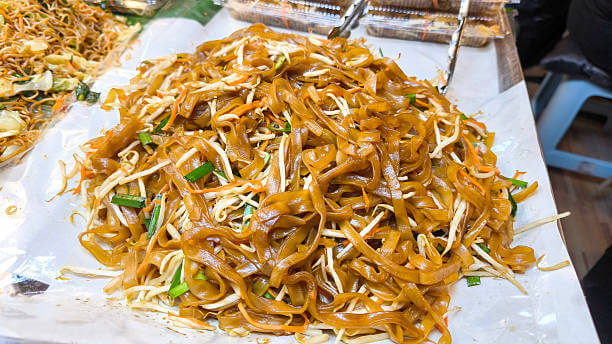
Pad Thai rice noodles are an essential ingredient in many Southeast Asian dishes, beloved for their smooth texture and adaptability. While they are famously associated with the classic Pad Thai dish, these noodles are far more versatile than many realize. Whether you are an experienced cook or just beginning your culinary journey, understanding how to use pad thai rice noodles can open up a world of flavorful possibilities. This article explores the origins, preparation techniques, and innovative ways to incorporate these noodles into everyday meals.
What Are Pad Thai Rice Noodles?
Pad Thai rice noodles are flat, medium-thick rice noodles made from rice flour and water. Unlike traditional wheat pasta, they are naturally gluten-free and have a delicate texture that absorbs flavors easily. These noodles are generally sold dried and require soaking or brief boiling before being added to dishes. Their smooth surface and firm bite when cooked properly make them ideal for stir-fries, soups, and salads. Their popularity extends beyond Thailand, becoming a staple ingredient in kitchens worldwide.
How to Prepare Pad Thai Rice Noodles Perfectly
The key to cooking pad thai rice noodles lies in preparation. Unlike pasta, these noodles should not be boiled extensively, as they can quickly become mushy. Instead, soak the dried noodles in warm water for 20 to 30 minutes until they become soft but still have some firmness. If you prefer boiling, do so briefly for 2 to 3 minutes and immediately rinse under cold water to halt the cooking process and remove excess starch. Properly prepared noodles will maintain their texture and absorb sauces beautifully in stir-fries or soups.
Creative Ways to Use Pad Thai Rice Noodles
While Pad Thai is the classic dish that brought these noodles worldwide fame, pad thai rice noodles can be transformed into numerous other meals. Try tossing them in a tangy lime and chili dressing with fresh herbs for a refreshing noodle salad. Use them in a hearty soup with coconut milk, lemongrass, and mushrooms for warming comfort. For a quick stir-fry, pair the noodles with garlic, vegetables, and your choice of protein, adding a splash of soy or oyster sauce. Their neutral taste allows them to complement a wide range of flavors from different cuisines, making them an excellent ingredient for fusion dishes.
Tips for Cooking with Pad Thai Rice Noodles
To get the most from pad thai rice noodles, it’s important to use high heat during stir-frying to achieve that signature slight char and smoky aroma. Avoid overcrowding the pan, which can cause noodles to steam rather than fry, leading to sogginess. Gently toss the noodles with your sauce and ingredients to prevent breaking. If your noodles stick together after cooking, a quick toss with a little toasted sesame oil or vegetable oil will help separate them. Finally, don’t over-sauce your dish pad thai rice noodles are great at soaking up flavors but can become limp if drowned in liquids.
Health Benefits of Pad Thai Rice Noodles
Pad Thai rice noodles are naturally free of gluten and dairy, making them suitable for many dietary preferences and restrictions. They are low in fat and calories, serving as a light base for nutrient-dense meals. When paired with fresh vegetables, lean proteins, and homemade sauces, they become part of a balanced and wholesome diet. Additionally, since these noodles are minimally processed, they contain fewer additives than many other types of packaged noodles, aligning well with clean-eating lifestyles.
FAQs
Are pad thai rice noodles gluten-free?
Yes, because they are made from rice flour and water, pad thai rice noodles are naturally gluten-free. Always check packaging if you have severe allergies, as cross-contamination is possible.
How long do I soak pad thai rice noodles before cooking?
Typically, soaking for 20 to 30 minutes in warm water is sufficient. They should be pliable but not fully soft, as they will finish cooking in the pan.
Can pad thai rice noodles be used in soups?
Absolutely. They absorb broth flavors well and hold their texture if added at the right time to avoid overcooking.
How do I prevent the noodles from sticking?
Rinse soaked or boiled noodles with cold water and toss with a little oil. When cooking, keep the heat high and avoid overcrowding the pan.
Can I substitute pad thai rice noodles for other noodles?
Yes, but keep in mind the texture differs from wheat noodles. Pad thai rice noodles work best in stir-fries, salads, and soups that benefit from their slightly chewy texture.
Conclusion
Pad Thai rice noodles offer a unique combination of texture, flavor absorption, and health benefits that make them a valuable ingredient in any kitchen. Whether you’re recreating the famous Thai dish or exploring new culinary horizons, mastering the preparation and use of these noodles can elevate your meals. Their adaptability makes them perfect for a wide variety of recipes, from quick weeknight dinners to more elaborate dishes. Incorporate pad thai rice noodles into your cooking repertoire and discover a delicious, gluten-free alternative that complements countless flavors.
Author Bio:
Suwanee Srisakorn is an expert in Thai cuisine and the creative mind behind Simply Suwanee. She passionately shares authentic recipes and cooking tips that bring Thai flavors to your table. Visit her website to explore more culinary inspiration and learn how to make delicious Thai dishes at home.
